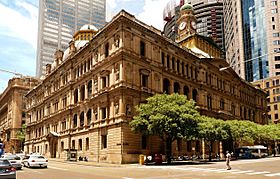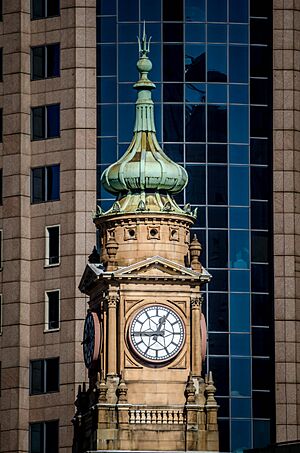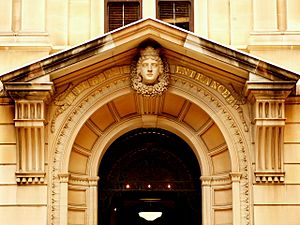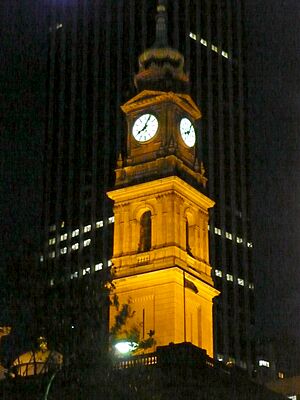Department of Lands building facts for kids
Quick facts for kids Department of Lands building |
|
|---|---|

Bridge Street façade of the Department of Lands building
|
|
| General information | |
| Type | Government administration |
| Architectural style | Victorian Renaissance Revival |
| Address | 22-33 Bridge Street, Sydney, New South Wales |
| Country | Australia |
| Coordinates | 33°51′50″S 151°12′36″E / 33.863915°S 151.209933°E |
| Current tenants | Pontiac Land Group |
| Construction started | 1876 |
| Estimated completion | 1892 |
| Owner | Government of New South Wales |
| Height | |
| Roof | Copper dome, 17 metres (55 ft) square to octagon |
| Dimensions | |
| Other dimensions | Clock tower with copper 'onion' top |
| Technical details | |
| Structural system | Reinforced concrete slabs |
| Material | Pyrmont sandstone |
| Floor count | 3 |
| Design and construction | |
| Architect |
|
| Architecture firm | Colonial Architect of New South Wales |
| Developer | Government of New South Wales |
| Main contractor |
|
| Official name: Lands Department Building | |
| Type: | State heritage (built) |
| Designated: | 2 April 1999 |
| Reference #: | 744 |
| Type: | Administration Office |
| Category: | Government and Administration |
The Department of Lands building is a beautiful, old government building in Sydney, Australia. It was designed in a style called Victorian Renaissance Revival. This large, three-storey building was created by Colonial Architect James Barnet. Other architects like Walter Liberty Vernon and William Edmund Kemp also helped with parts of the design. The main builder was John Young.
This building was once home to the NSW Department of Lands. This department was very important during the late 1800s when many new settlements were being built across New South Wales. The building is now listed on the New South Wales State Heritage Register, which means it's a protected historical site. In the late 1980s, there was a plan to change the building into something else, but the Heritage Council of New South Wales stepped in to protect its history.
The NSW Office of Environment & Heritage moved out in 2016. Now, the building is being turned into a fancy hotel by the Pontiac Land Group. It's part of a bigger project called "the sandstone precinct" that includes the nearby Department of Education building.
Contents
Where is the Building Located?
The Department of Lands building is in a very important spot in Sydney. It's on a city block surrounded by Bridge, Loftus, Bent, and Gresham Streets. When it was first built, it was "downhill" from the original Government House. That old Government House site is now where the Museum of Sydney stands.
The building's design allowed for amazing views of Port Jackson and Sydney Cove from its northern side. For many years, it was the main office for important figures like the Surveyor General and the Colonial Architect.
A Look at the Building's Past
The Lands Department Building was built in two main stages. The first part was from 1876 to 1881, designed by James Barnet. The second part was from 1888 to 1892, overseen by Walter Vernon. Interestingly, the first stage used a new building method called reinforced concrete slabs, thanks to the builder John Young. He was one of the first in Sydney to use this technique.
Around 1887 to 1894, a special marker called the Lands Department Datum Bench Mark Plug was placed on the front of the building. This marker became the starting point for all height measurements across New South Wales. In 1938, a clock was added to the tower, along with a system of clocks throughout the building, all made in Australia.
In the late 1980s, the NSW Government thought about changing the building's use. However, the NSW Heritage Council issued a special order to protect the building. This order made sure the building's historical features would be kept safe.
The NSW Department of Planning and Environment moved out in September 2016. The building had been used by the NSW Government (specifically the Department of Lands) since it was finished in 1892. Now, it's being carefully renovated to become a hotel, keeping its historical look for future visitors to enjoy.
What Does the Building Look Like?
James Barnet designed the building in the Victorian Renaissance Revival style. He liked using classical styles for public buildings. It's a large, three-storey building made of sandstone, with a basement.
The building has three entrances in the basement. The main one is on Bridge Street, and two others are on Gresham Street. The outside walls, called façades, are made of finely cut Pyrmont sandstone. They have decorative cornices (top edges) and balusters (small pillars) on each floor. The dome and tower tops are made of copper.
All four sides of the building are richly decorated with classical designs and statues. Each side looks a bit different. Barnet cleverly mixed different classical styles. For example, the lowest part of the building has Doric and Ionic pilasters (flat columns), while the upper levels use Corinthian and Ionic ones. The clock tower has a unique 'onion' shaped copper dome. It's said that this design was inspired by Sir Henry Parkes's water carafe!
The ground, first, and second floors feature different types of pilasters and entablatures (the part above the columns). The roof is hidden behind a decorative parapet (a low wall). A large copper dome, 17 metres (55 ft) square at its base, changes to an octagon at the top. It has a smaller octagonal lantern with a spinning copper roof.
The parts of the building facing Gresham and Loftus Streets have pediments (triangular tops) with high mansard roofs behind them. A clock tower with its copper "onion" top can be seen from Bent and Spring Streets. The building has arched windows and veranda openings. There are also niches (recessed spaces) for statues. You can see detailed cast-iron work on the entrance gates and window grilles. Inside, there are grand stairs and balconies that stick out over the courtyards.
The inside walls are made of brick, with reinforced concrete floors and ceilings. The roof has iron frames. The outside of the building still looks just as it did when it was first built.
When it was finished, it was the largest public building of its time. It had the newest office technology, like speaking tubes, pneumatic bells, and spiral stairs. At the main entrance, there's a mosaic of Queen Victoria's coat of arms. Barnet also designed a special plan room with a heavy, fireproof metal door.
The Statues of the Building
Each of the four sides of the building has twelve empty spaces, called niches. These were meant for statues of explorers and lawmakers who helped open up and settle Australia. James Barnet suggested 48 people, but many were rejected. Only 23 statues were made. These include famous figures like Hamilton Hume, William Hovell, Major Sir Thomas Mitchell, Gregory Blaxland, William Lawson, William C. Wentworth, George Bass, Matthew Flinders, and Sir Joseph Banks.
The most recent statue added was James Meehan in 2010. This means there are still 24 empty niches waiting for more statues!
Recent Changes to the Building
In November 2010, a new statue of colonial surveyor James Meehan (1774-1826) was placed in an empty niche on the corner of Loftus and Bent Streets. Meehan came to NSW in 1800. He was a teacher and a skilled surveyor. He worked for the Acting Surveyor-General and went on two big expeditions within two years. By 1806, he had been pardoned and continued his important work.
James Meehan became a very important surveyor, explorer, and settler. He surveyed and mapped large parts of the country. Early towns like Sydney, Parramatta, Bathurst, Port Macquarie, and Hobart were all explored and mapped by him. The statue was put there to celebrate his important work.
Why is This Building Important?
As of 2006, the Department of Lands building is considered one of the most amazing Victorian-era buildings still standing in Sydney. It has always been used for its original purpose: as the main office for the Department of Lands. It has a long connection to public life in New South Wales, especially during the rapid growth of settlements in the late 1800s.
The building fits in perfectly with other government buildings at the eastern end of Bridge Street. It's a key landmark in the history of surveying, land titles, and public works in New South Wales.
The Lands Department Building was added to the New South Wales State Heritage Register on 2 April 1999 because it met several important criteria:
- It shows how New South Wales history unfolded.
The Lands Department Building is one of the most important public buildings built in Australia during the mid-1800s. The work of the Lands Department was crucial for the growth of the colony. The building's style and size were considered as grand as other public buildings in the British Empire. It made the people of Sydney proud and helped them feel connected to their European heritage. Important Australian figures like Surveyor General Sir Thomas Mitchell and architect James Barnet are also linked to this building.
- It shows great artistic and technical skill in New South Wales.
The Lands Department Building is famous for its unique look, especially the statues on its outside. It's considered one of the most complete examples of late Victorian-Edwardian style buildings in Sydney. Barnet's designs were different from older architectural styles in Sydney. He used grand columns and verandas, which were good for the Australian climate.
- It has a strong connection to the community and culture of New South Wales.
This building is a very important historical item from early colonial times. Today, people widely recognize its historical value. It's seen as a building that helps define Australian identity. Along with other classical buildings like the General Post Office and the Chief Secretary's building, it shows the wealth of the nation and the pride of having structures that reflect a connection to the British Empire. The building is very impressive and attracts both tourists and locals who are interested in history.
Images for kids





